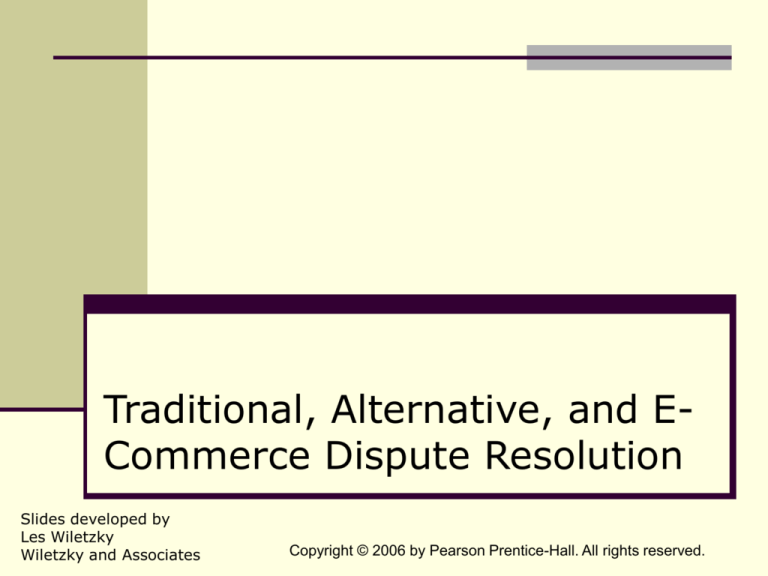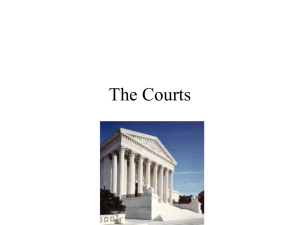
Traditional, Alternative, and ECommerce Dispute Resolution
Slides developed by
Les Wiletzky
Wiletzky and Associates
Copyright © 2006 by Pearson Prentice-Hall. All rights reserved.
There are two major court systems
in the U.S.:
1. The federal court system
2. The court systems of the 50 states and
the District of Columbia
Each of these systems has jurisdiction
to hear different types of lawsuits
Copyright © 2006 by Pearson Prentice-Hall. All rights reserved.
3-2
Dispute Resolution
Litigation
The process of bringing,
maintaining, and
defending a lawsuit
difficult
time-consuming
costly
complex procedural rules
Alternative Dispute
Resolution
Nonjudicial dispute
resolution developed in
response to the expense
and difficulty of bringing a
lawsuit
Being used more often to
resolve commercial and ecommerce disputes
Copyright © 2006 by Pearson Prentice-Hall. All rights reserved.
3-3
The State Court Systems (1 of 4)
1. LimitedJurisdiction
Trial Courts
2. GeneralJurisdiction
Trial Courts
4. State Supreme
Court
3. Intermediate
Appellate Courts
Copyright © 2006 by Pearson Prentice-Hall. All rights reserved.
3-4
The State Court Systems (2 of 4)
Limited – Jurisdiction Trial Court
Hears matters of a specialized or limited nature
Traffic courts
Juvenile courts
Justice-of-the-peace
Family law courts
Small claims courts
Courts that hear
courts
Probate courts
Copyright © 2006 by Pearson Prentice-Hall. All rights reserved.
misdemeanor
criminal law cases
and civil lawsuits
under a certain dollar
amount
3-5
The State Court Systems (3 of 4)
General – Jurisdiction
Trial Court
Hears cases of a general
nature that are not within
the jurisdiction of limitedjurisdiction courts
Testimony and evidence at
trial are recorded and
stored for future reference
Intermediate Appellate
Court
An intermediate court that
hears appeals from trial
courts
Reviews the trial court
record to determine if there
have been any errors at
trial that would require
reversal or modification of
the decision
Copyright © 2006 by Pearson Prentice-Hall. All rights reserved.
3-6
The State Court Systems (4 of 4)
State Supreme Court
The highest court in a state court system
Hears appeals from intermediate state courts
and certain trial courts
No new evidence or testimony is heard
Decisions of state supreme courts are final,
unless a question of law is involved that is
appealable to the U.S. Supreme Court
Copyright © 2006 by Pearson Prentice-Hall. All rights reserved.
3-7
Appeal to
U.S. Supreme Court
State
Supreme
Court
A Typical State
Court System
State
Appeals
Courts
State Trial
Courts of
General
Jurisdiction
Civil
Division
Criminal
Division
Small
Claims
Courts
Probate
Division
Municipal
Courts
Copyright © 2006 by Pearson Prentice-Hall. All rights reserved.
Domestic
Relations
Division
Juvenile
Division
Justice
of the
Peace
Courts
3-8
Factors to consider in deciding to
bring or settle a lawsuit: (1 of 2)
The probability of winning or losing
The amount of money to be won or lost
Lawyers’ fees and other costs of litigation
Loss of time by managers and other personnel
The long-term effects on the relationship and
reputation of the parties
The amount of prejudgment interest provided by
law
Copyright © 2006 by Pearson Prentice-Hall. All rights reserved.
3-9
Factors to consider in deciding to
bring or settle a lawsuit: (2 of 2)
The aggravation and psychological costs
associated with a lawsuit
The unpredictability of the legal system and the
possibility of error
Other factors peculiar to the parties and lawsuit
Copyright © 2006 by Pearson Prentice-Hall. All rights reserved.
3 - 10
The Federal Court System (1 of 8)
1. Special
Federal Courts
2. U.S. District
Courts
4. U.S. Supreme
Court
3. U.S. Courts
Of Appeals
Copyright © 2006 by Pearson Prentice-Hall. All rights reserved.
3 - 11
The Federal Court System (2 of 8)
Special Federal Courts
Federal courts that hear matters of
specialized or limited jurisdiction
They include:
U.S. Tax Court
U.S. Claims Court
U.S. Court of International Trade
U.S. Bankruptcy Courts
Copyright © 2006 by Pearson Prentice-Hall. All rights reserved.
3 - 12
The Federal Court System (3 of 8)
U.S. District Courts
The federal court system’s trial courts of
general jurisdiction
They are empowered to:
Impanel juries
Receive evidence
Hear testimony
Decide cases
Most federal cases originate in federal district
court
Copyright © 2006 by Pearson Prentice-Hall. All rights reserved.
3 - 13
The Federal Court System (4 of 8)
U.S. Courts of Appeals
The federal court system’s intermediate
appellate courts
These courts hear appeals from the district
courts located in their circuit
Copyright © 2006 by Pearson Prentice-Hall. All rights reserved.
3 - 14
The Federal Court System (5 of 8)
U.S. Courts of Appeals (continued)
These courts review the record of the lower
court or administrative agency proceedings to
determine if there has been any error that
would warrant reversal or modification of the
lower court decision
No new evidence or testimony is heard
Copyright © 2006 by Pearson Prentice-Hall. All rights reserved.
3 - 15
The Federal Court System (6 of 8)
U.S. Supreme Court
The Supreme Court was created by Article III
of the U.S. Constitution
The Supreme Court is the highest court in the
land and is located in Washington, D.C.
Copyright © 2006 by Pearson Prentice-Hall. All rights reserved.
3 - 16
The Federal Court System (7 of 8)
U.S. Supreme Court (continued)
The Supreme Court hears appeals from
federal circuit courts of appeals and, under
certain circumstances, from federal district
courts, special federal courts, and the highest
state courts
No new evidence or testimony is heard
Copyright © 2006 by Pearson Prentice-Hall. All rights reserved.
3 - 17
The Federal Court System (8 of 8)
U.S. Supreme Court (continued)
The lower court record is reviewed to
determine whether there has been an error
that warrants a reversal or modification of the
decision
The Supreme Court’s decision is final
Copyright © 2006 by Pearson Prentice-Hall. All rights reserved.
3 - 18
U.S. Supreme
Court
(Washington, D.C.)
U.S. Court of Appeals
(for 11 Territorial
Circuits and D.C.
Circuit)
Federal
Administrative
Agencies
U.S.
District
Courts
The Federal
Court System
U.S. Court of Appeals
for the Federal Circuit
U.S. Tax
Court
U.S. Claims
Court
U.S. Court
of International
Trade
U.S. Patent
and
Trademark
Office
U.S.
Bankruptcy
Courts
Copyright © 2006 by Pearson Prentice-Hall. All rights reserved.
3 - 19
Decisions by the U.S. Supreme
Court (1 of 2)
Petition for Certiorai
A petition asking the
Supreme Court to
hear one’s case
Writ of Certiorai
An official notice that
the Supreme Court
will review one’s case
Copyright © 2006 by Pearson Prentice-Hall. All rights reserved.
3 - 20
Decisions by the U.S. Supreme
Court (2 of 2)
The Supreme Court can issue the
following types of decisions:
Unanimous decision
Majority decision
Plurality decision
Tie decision
Copyright © 2006 by Pearson Prentice-Hall. All rights reserved.
3 - 21
Jurisdiction of Federal and State
Courts
1.
Exclusive Federal
Jurisdiction
Admiralty
2.
Antitrust
3.
Bankruptcy
4.
Copyright
5.
Federal Crimes
6.
Patents
7.
Suits against
the U.S.
8.
Other specified
federal statutes
Exclusive State
Jurisdiction
Concurrent
Jurisdiction
1.
Federal
questions
2.
Diversity of
citizenship
cases
Copyright © 2006 by Pearson Prentice-Hall. All rights reserved.
Matters not subject to
federal jurisdiction
3 - 22
The Jurisdiction and Venue of
Courts
1. Standing to sue
2. Subject matter
jurisdiction
3. In personam
jurisdiction (or
personal
jurisdiction)
4. In rem jurisdiction
5. Quasi in rem
jurisdiction
6. Long-arm statutes
7. Venue
8. Forum selection
clause
Copyright © 2006 by Pearson Prentice-Hall. All rights reserved.
3 - 23
The Pretrial Litigation Process
1. Pleadings
2. Discovery
3. Dismissals and
Pretrial Judgments
4. Settlement
Conference
Copyright © 2006 by Pearson Prentice-Hall. All rights reserved.
3 - 24
The Trial
Pursuant to the Seventh Amendment to the U.S.
Constitution, a party to an action at law is
guaranteed the right to a jury trial in cases in
federal court
Most state constitutions contain a similar guarantee
for state court actions
If either party requests a jury, the trial will be by jury
If both parties waive their right to a jury, the trial will
be without a jury
Copyright © 2006 by Pearson Prentice-Hall. All rights reserved.
3 - 25
Phases of a Trial
1.
2.
3.
4.
5.
6.
7.
8.
9.
Jury Selection
Opening Statements
The Plaintiff’s Case
The Defendant’s Case
Rebuttal and Rejoinder
Closing Arguments
Jury Instructions
Jury Deliberation
Entry of Judgment
Copyright © 2006 by Pearson Prentice-Hall. All rights reserved.
3 - 26
The Appeal
In a civil case,
either party can appeal the trial court’s decision,
once a final judgment is entered
In a criminal case,
only the defendant can appeal
Notice of appeal must be filed within a
prescribed time after judgment is entered to the
appropriate appellate court
Copyright © 2006 by Pearson Prentice-Hall. All rights reserved.
3 - 27
Alternative Dispute Resolution
(ADR)
Nonjudicial means of resolving legal
disputes
Developed in response to the expense
and difficulty of bringing a lawsuit
ADR usually saves time and money of
costly litigation
Copyright © 2006 by Pearson Prentice-Hall. All rights reserved.
3 - 28
Types of ADR
Arbitration
Mediation
Minitrial
Conciliation
Fact-Finding
Copyright © 2006 by Pearson Prentice-Hall. All rights reserved.
Judicial Referee
3 - 29
Key ADR Legislation
Federal Arbitration Act
Arbitration agreements involving commerce
are valid, irrevocable, and enforceable
contracts
Uniform Arbitration Act
Adopted by half of the states.
Promotes the arbitration of disputes at the
state level
Copyright © 2006 by Pearson Prentice-Hall. All rights reserved.
3 - 30








